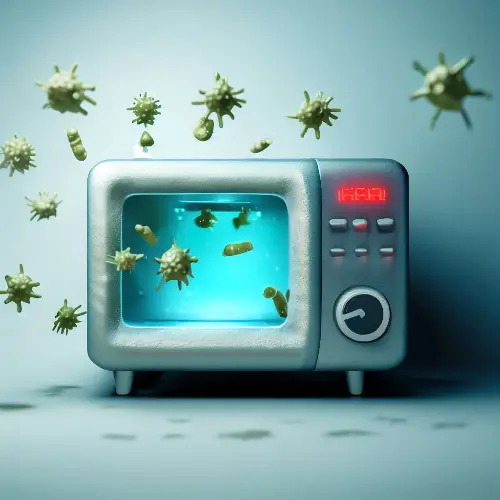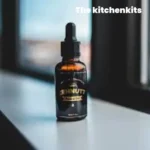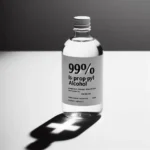Table of Contents
Does 30 seconds in microwave kill germs
No, 30 seconds in the microwave is generally not enough to effectively kill germs. Microwaves are a convenient appliance found in most kitchens for quickly heating and cooking food. Some people also use microwaves as a way to kill germs and disinfect items.
But can simply microwaving your food or other items for 30 seconds effectively kill harmful bacteria and viruses? Let’s take a closer look at what the research says.
How Do Microwaves Work To Heat And Cook Food?
Microwaves work by generating electromagnetic waves that cause water molecules in food to vibrate rapidly, creating friction that heats the food. This differs from conventional ovens that rely on heated air to transfer heat into food.
The microwaves penetrate food quite evenly, so microwaved food often heats more uniformly than food cooked in a standard oven. However, due to variances in food composition, density, and shape, there can still be hot and cold spots in microwaved foods.
Can Microwaves Kill Harmful Bacteria and Viruses?
Research has shown that microwaves can kill bacteria and viruses by heating them to sufficiently high temperatures. However, the effectiveness depends on several factors:
- Type of germs – Some types of bacteria, like Salmonella, are more susceptible to being killed by heat than other types. Viruses can be harder to kill than bacteria.
- The temperature reached – Bacteria and viruses are killed once the internal temperature of the food reaches about 165°F (74°C). Some spore-forming bacteria require even higher temperatures.
- Time exposed – The longer the food is heated at bactericidal temperatures, the more thorough the killing of microbes. Quickly microwaving for only 30 seconds may not heat all areas evenly to 165°F.
- Food composition – High fat/protein foods heat more evenly, while foods with lots of water (like vegetables) heat less uniformly. Bacteria can survive in cold spots.
- Moisture content – Bacteria survive longer in wet foods. Microwaved foods that still contain moisture can allow bacteria to survive.
So while microwaves can kill bacteria and viruses when used properly, just 30 seconds may not be long enough to reliably kill harmful germs in many foods.
Microwaving Specific Foods and Items
Raw Meats, Poultry, Fish
Raw animal products can contain dangerous pathogens like Salmonella, E. coli, and Listeria. The CDC recommends cooking raw meats to at least 165°F internal temperature, measured with a food thermometer, to destroy foodborne bacteria.
Quickly microwaving raw meats for only 30 seconds is unlikely to heat it sufficiently throughout to 165°F to kill bacteria. Microwaving to a safe internal temperature takes much longer, often several minutes depending on thickness and amount. So 30 seconds is inadequate for making raw meats safe to eat.
Leftovers and Reheated Foods
Similarly, reheating leftover foods or cooked foods in the microwave for only 30 seconds may not make them safe, especially if they’ve been sitting at room temperature for a period of time, allowing bacteria like Salmonella or Listeria to multiply.
The USDA recommends reheating leftovers to 165°F as measured with a food thermometer. This usually takes at least 2 minutes in the microwave.
Fruits and Vegetables
Fresh produce like fruits, vegetables, and herbs can harbor germs like Salmonella and E. coli if they’re contaminated. However, simply microwaving produce for 30 seconds isn’t considered a reliable way to remove pathogens.
It’s better to wash produce thoroughly before eating. If cooking produces, aim for cooking times and temperatures hot enough to kill bacteria.
Kitchen Sponges
Studies have found that microwaving damp kitchen sponges for 60 seconds to 2 minutes can effectively kill up to 99% of bacteria, viruses, and fungi living within the sponges. This is because the microwave heat penetrates and disinfects the whole sponge, including the inner layers where bacteria can hide. 30 seconds may kill some but not all germs.
Hard Surfaces
Microwaving won’t effectively disinfect countertops or other hard surfaces in the kitchen. The microwaves pass through the air and solid materials without heating them up. Some people mistakenly think because the microwave interior gets hot, it will kill germs – but the heat inside is from the food, not the surface itself.
Is It Safe To Microwave Plastic Containers and Wraps?
Heating plastics in the microwave can potentially cause chemicals to migrate from the plastic into the food. The FDA recommends avoiding microwaving plastics with recycling codes 3 (phthalates like DEHA), 6 (styrene), and 7 (bisphenol A or BPA) as these contain chemicals that could leach into food during heating.
Safer microwave-safe plastics have recycling codes 1, 2, 4, and 5 and most products are labeled “microwave safe.” Never microwave plastic foam containers, which can melt or warp.
Microwave Power Levels And Times Needed To Kill Germs
- 1000-1100 watts: 165°F reached after 3-4 minutes
- 700-900 watts: 165°F reached after 4-6 minutes
- 500-600 watts: 165°F reached after 6-8 minutes
Microwaves vary in power, so knowing your appliance’s wattage is important. Higher wattages heat food faster. Rotating and stirring food halfway helps it heat evenly. Use a food thermometer to check the internal temperature.
Tips For Safe Microwave Cooking
- Heat raw animal foods like poultry, meat, fish, and eggs thoroughly to 165°F.
- When reheating leftovers, heat to 165°F.
- Avoid microwaving in plastic containers or wraps labeled 3, 6, or 7.
- Use microwave-safe glass or ceramics whenever possible.
- Check for cold spots and stir foods occasionally while microwaving.
- Let microwaved foods stand for 2-3 minutes before eating.
- Clean microwave spills promptly to avoid bacterial growth.
The Bottom Line
Microwaves can kill bacteria and viruses by heating foods to temperatures adequate to destroy pathogens. However, research has shown that simply microwaving food for 30 seconds is generally not sufficient time to kill harmful germs.
To kill bacteria and viruses in food, it needs to reach an internal temperature of 165°F (74°C) or above for several minutes at least. Always use safe handling and thorough cooking practices to prevent foodborne illnesses.
FAQs
Can you put a sponge in the microwave to kill germs?
Yes, you can disinfect a damp sponge in the microwave. Studies have found that microwaving wet sponges for 1-2 minutes at full power can eliminate up to 99% of bacteria, viruses, and fungi living in kitchen sponges. The microwave heat is able to penetrate deep into the sponge and kill germs inside it. Be sure the sponge doesn’t contain any metal scrubbers before microwaving.
Does microwaving food kill the coronavirus?
Microwaving food to a temperature of at least 165°F (74°C) can effectively kill coronaviruses like SARS-CoV-2, the virus that causes COVID-19. However, quickly microwaving for only 30 seconds or less is unlikely to get the food hot enough throughout to inactivate the virus. Reheating leftovers in the microwave until steaming hot (165°F) helps kill viruses and bacteria that may be present.
Can you put shoes in the microwave to kill germs?
No, you should not put shoes in the microwave. Microwave ovens are meant for heating food and items containing water molecules like kitchen sponges. Shoes don’t contain water, so microwaving them will not effectively kill germs or disinfect them. The shoes may also catch fire or melt from overheating. It’s better to use disinfectants safe for shoes or wash shoes in hot water and let them air dry.
Does microwaving food kill nutrients?
Microwaving can destroy some nutrients in food, especially vitamin C, certain B vitamins like B1, folate, and thiamine, and antioxidants. However, compared to cooking on the stove or in the oven, microwaving causes less nutrient loss overall in most foods because it cooks faster and without water or oil. Microwaving with a small amount of water can help minimize the loss of sensitive vitamins.
Is it safe to microwave food in plastic containers?
It’s best to avoid microwaving foods in plastic containers or wraps containing phthalates, styrene, and BPA (recycling codes 3, 6, and 7) as these plastics may allow chemicals to leach into foods during heating. Safer options are microwave-safe plastics labeled with recycling codes 1, 2, 4, and 5. Glass or ceramic microwave-safe containers are recommended when possible. Do not microwave any plastic foam food containers.
Can the microwave sterilize jars?
Yes, the microwave can be used to sterilize glass jars used for canning and preserving foods. Wash jars in hot, soapy water first. Then microwave the empty jars on high for 2-3 minutes until boiling hot. Carefully remove them using potholders and keep jars hot until filling. This heat treatment kills bacteria for short-term storage. The jars should still be processed properly after filling.
Does microwaving water kill bacteria?
Microwaving water alone may not reliably kill all bacteria. The research found that microwaving contaminated water for 30 seconds reduced bacteria levels but did not eliminate all bacteria present. Heating water to a rolling boil for 1 minute is a more reliable way to kill any bacteria in drinking water. However, it’s best to start with filtered or bottled water if water quality is a concern.
Conclusion
In conclusion, while using your microwave can heat and cook foods as well as sterilize kitchen sponges, it has limitations when it comes to killing harmful bacteria and viruses in some situations. Quickly microwaving food for only 30 seconds is generally insufficient to destroy pathogens. Proper cooking times and temperatures are necessary.
To kill germs in food, it typically needs to reach 165°F internally and be held at that temperature for several minutes. Always use caution with handling and thoroughly cooking raw meats, reheating leftovers, and microwaving plastics. Following food safety guidelines helps prevent foodborne illnesses when using your microwave.

I’m Ian Welkins, a seasoned professional in the kitchen industry. My passion now drives me to provide invaluable insights into the world of top-notch kitchen products. With years of hands-on experience, I’m your go-to source for culinary excellence.











